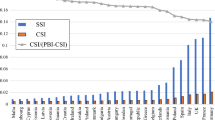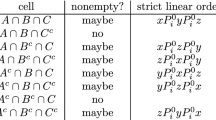Abstract
Two measures, the weight of coalitions and the probability of situations in decision making, are used to characterize the representativeness, i.e. the capability of individuals to represent the social preference. It is proved that there always exists an individual who represents a majority on average, and an individual who represents a majority in most cases. This result is applied to Arrow's social choice model. It follows that there always exists a dictator who is a representative of the society rather than a dictator in a proper sense. After the concept of dictator has been refined to a dictator in a proper sense, Arrow's axioms become consistent. The idea of optimal representation is extended to limited groups of representatives which make decisions on behalf of the whole society. We consider the cabinet (named by analogy with the cabinet of ministers) which consists of a few representatives with delimited domains of competence, and the council which makes decisions by means of voting. It is shown that the representativeness of optimal cabinets and councils tends to 100% of maximally possible values as the number of their members increases, independently of the size of the society. We suggest a geometric interpretation of optimal representatives, cabinets, and councils, based on approximation formulas for the indicators of representativeness derived for the model with a large number of independent individuals. Finally, for cabinets and councils we establish the consistency of different concepts of optimality with respect to different indicators of representativeness. Our consideration is applicable to multicriteria decision making. An appointment of a cabinet or a council corresponds to selecting a few partial criteria. Therefore, the obtained results can be used for reducing the set of partial criteria to a certain sufficient minimum. The concepts of dictator, cabinet, and council can be understood as models of president, government, and parliament, respectively. Thus our results justify reducing social choice to individual choice or small group choice. Although it is in use in all democratic systems, its acceptability is not evident at all. In other words, we justify the demoncraticity of such forms of political power as the president, the parliament, and the government.
Similar content being viewed by others
References
Abramowitz M, Stegun I (1972) Handbook of mathematical functions. New York: Dover
Armstrong TE (1980) Arrow's theorem with restricted coalition algebras. J Math Econ 7(1): 55–75
Armstrong TE (1985) Precisely dictatorial social welfare functions. Erratum and addendum to ‘Arrow's theorem with restricted coalition algebras’. J Math Econ 14(1): 57–59
Arrow KJ (1951) Social choice and individual values. New York: Wiley
Black D (1958) The theory of committees and elections. Cambridge: Cambridge University Press
Fishburn PC (1970) Arrow's impossibility theorem: concise proof and infinite voters. J Econ Theory 2(1): 103–106
Fishburn PC (1987) Interprofile conditions and impossibility. Chur: Harwood Academic Publishers
Kelly JS (1978) Arrow impossibility theorems. New York: Academic Press
Kirman A, Sondermann D (1972) Arrow's theorem, many agents, and invisible dictators. J Econ Theory 5(2): 267–277
Larichev OI (1979) The science and the art of decision making. Moscow: Nauka (Russian)
Schmitz N (1977) A further note on Arrow's impossibility theorem. J Math Econ 4(3): 189–196
Tanguiane AS (1980) Hierarchical model of group choice. Ekonomika i matematicheskiye metody (Russian) 16(3): 519–534
Tanguiane AS (1981) Transition to an infinite number of individuals in a model of group choice. Ekonomika i matematicheskiye metody (Russian) 17(1): 109–120
Tanguiane, AS (1989) Optimal dictatorial and multi-dictatorial choice in Arrow's model with applications to multicriteria decision making. In: Gruber J (ed) Econometric decision models: new methods of modeling and applications. Proceedings of the second international conference on econometric decision models, University of Hagen, held in Haus Nordhelle, August 29-September 1, 1989. Lecture Notes in economics and mathematical systems, Vol 366. Berlin, Heidelberg, New York: Springer 1991, pp248–266
Tanguiane AS (1991a) Aggregation and representation of preferences. Introduction to mathematical theory of democracy. Berlin, Heidelberg, New York: Springer
Tanguiane AS (1991b) Overcoming Arrow's paradox and development of the mathematical theory of democracy. Hagen: Fern-Universität, Discussion Paper No 160
Tanguiane AS (1991c) Optimal appointment of vice-president and recurrent construction of cabinets and councils. Hagen: Fern-Universität, Discussion Paper No 161
Tanguiane AS (1992) Inefficiency of democratic decision making in an unstable society. Hagen: Fern-Universität, Discussion Paper No 185
Author information
Authors and Affiliations
Rights and permissions
About this article
Cite this article
Tanguiane, A.S. Arrow's paradox and mathematical theory of democracy. Soc Choice Welfare 11, 1–82 (1994). https://doi.org/10.1007/BF00182898
Received:
Accepted:
Issue Date:
DOI: https://doi.org/10.1007/BF00182898




